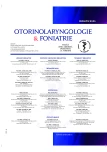Inverted Sinonasal Papilloma: Possibility of Prediction of the Tumor Insertion
Authors:
P. Schalek; A. Guha; M. Šteffl; M. Chovanec
Authors place of work:
Otorinolaryngologická klinika 3. LF UK a Fakultní nemocnice Královské Vinohrady, Praha
Published in the journal:
Otorinolaryngol Foniatr, 68, 2019, No. 2, pp. 75-78.
Category:
Původní práce
Summary
Introduction: Sinonasal inverted papilloma is a benign and relatively rare tumor of the sinonasal tract. The tumor is characterized by destructive growth, frequent recurrences and coincident with squamous cell carcinoma. Currently, the endoscopic surgery is considered to be basic treatment modality for inverted papillomas. The identification of the tumor insertion represents the most important step of the surgical procedure. The insertion can be predicted preoperatively using imaging methods, especially by searching for so-called focal hyperostosis. The aim of the study is prospective evaluation possible correlation between pre and perioperative identification of the tumor insertion.
Material and methods: In 27 patients with histologically confirmed inverted papilloma, the insertion was preoperatively determined by identification of focal hyperostosis. The expected location was then correlated with perioperative finding.
Results: The preoperative analysis of CT scans revealed hyperostosis in 74 % of patients. The pre- and perioperative correlation of the tumor insertion was 95 %.
Conclusion: Once the focal hyperostosis is identified, the location likely corresponds with the tumor insertion. The preoperative identification of the tumor insertion enables planning of the extent of the procedure with good radicality and minimal morbidity.
Keywords:
inverted papilloma – tumor insertion – focal hyperostosis – Endoscopic surgery
Zdroje
1. Bhalla, R. K., Wright, E. D.: Predicting the site of attachment of sinonasal inverted papilloma. Rhinology, 47, 2009, 4, s. 345-348.
2. Byun, J. Y., Lee, S. H., Shin, J. M. et al.: Overexpression of angiomotin in sinonasal inverted papilloma. Int Forum Allergy Rhinol, 4, 2014, 6, s. 512-516.
3. Fang, G., Lou, H., Yu, W. et al.: Prediction of the originating site of sinonasal inverted papilloma by preoperative magnetic resonance imaging and computed tomography. Int Forum Allergy Rhinol, 6, 2016, 12, s. 1221-1228.
4. Govindaraj, S., Wang, H.: Does human papilloma virus play a role in sinonasal inverted papilloma? Curr Opin Otolaryngol Head Neck Surg, 22, 2014, 1, s. 47-51.
5. Hyams, V. J.: Papillomas of the nasal cavity and paranasal sinuses. A clinicopathological study of 315 cases. Ann Otol Rhinol Laryngol, 80, 1971, 2, s. 192-206.
6. Klozar, J., Miřejovský, P., Betka J.: Invertovaný papilom ve spojení s karcinomem. Otorinolaryngol a Foniat /Prague/, 46,1997, 3, s.158–162.
7. Landsberg, R., Cavel, O., Segev, Y. et al.: Attachment-oriented endoscopic surgical strategy for sinonasal inverted papilloma. Am J Rhinol, 22, 2008, 6, s. 629-634.
8. Lee, D. K., Chung, S. K., Dhong, H. J. et al.: Focal hyperostosis on CT of sinonasal inverted papilloma as a predictor of tumor origin. AJNR Am J Neuroradiol, 28, 2007, 4, s. 618-621.
9. Lund, V. J., Lloyd, G. A.: Radiological changes associated with inverted papilloma of the nose and paranasal sinuses. Br J Radiol, 57, 1984, 678, s. 455-461.
10. Matoušek, P., Komínek, P.: Invertovaný papilom nosu a vedlejších nosních dutin. 2. část - Analýza vlastního souboru. Otorinolaryngol a Foniat /Prague/, 55, 2006, 2, s. 79-83.
11. McCary, W. S., Gross, C. W., Reibel, J. F. et al.: Preliminary report: endoscopic versus external surgery in the management of inverting papilloma. Laryngoscope, 104, 1994, 4, s. 415-419.
12. Nakamaru, Y., Fujima, N., Takagi, D. et al.: Prediction of the attachment site of sinonasal inverted papillomas by preoperative imaging. Ann Otol Rhinol Laryngol, 123, 2014, 7, s. 468-474.
13. Savy, L., Lloyd, G., Lund, V. J. et al.: Optimum imaging for inverted papilloma. J Laryngol Otol, 114, 2000, 11, s. 891-893.
14. Sham, C. L., King, A. D., van Hasselt, A. et al.: The roles and limitations of computed tomography in the preoperative assessment of sinonasal inverted papillomas. Am J Rhinol, 22, 2008, 2, s. 144-150.
15. Schalek, P., Fuhrmann, L.: Invertovaný sinonazální papilom - současné principy chirurgické léčby. Otorinolaryngol a Foniat /Prague/, 62, 2013, 1, s. 26-30.
16. Scheel, A., Lin, G. C., McHugh, J. B. et al.: Human papillomavirus infection and biomarkers in sinonasal inverted papillomas: clinical significance and molecular mechanisms. Int Forum Allergy Rhinol, 5, 2015, 8, s. 701-707.
17. Roh, H. J., Procop, G. W., Batra, P. S. et al.: Inflammation and the pathogenesis of inverted papilloma. Am J Rhinol, 18, 2004, 2, s. 65-74.
18. Waitz, G., Wigand, M. E.: Results of endoscopic sinus surgery for the treatment of inverted papillomas. Laryngoscope, 102, 1992, 8, s. 917-922.
19. Wang, M. J., Noel, J. E.: Etiology of sinonasal inverted papilloma: A narrative review. World J Otorhinolaryngol Head Neck Surg, 3, 2017, 1, s. 54-58.
20. Yousuf, K., Wright, E. D.: Site of attachment of inverted papilloma predicted by CT findings of osteitis. Am J Rhinol, 21, 2007, 1, s. 32-36.
Štítky
Audiologie a foniatrie Dětská otorinolaryngologie OtorinolaryngologieČlánek vyšel v časopise
Otorinolaryngologie a foniatrie

2019 Číslo 2
- Isoprinosin je bezpečný a účinný v léčbě pacientů s akutní respirační virovou infekcí
- Pacienti s infekcemi HPV a EBV a možnosti léčebné intervence pomocí inosin pranobexu
- Fexofenadin – nesedativní a imunomodulační antihistaminikum v léčbě alergických projevů
- Klinický obraz cytomegalové infekce
- Inosin pranobex v léčbě HPV infekcí děložního čípku
Nejčtenější v tomto čísle
- Video Head Impulse Test - nejnovější metoda vyšetření vestibulárního aparátu
- Efekt tréninku hlasu pomocí rezonančních cvičení brumenda u studentů – pilotní studie
- Invertovaný sinonazální papilom: možnost predikce inzerce tumoru
- Solitárny fibrózny tumor príušnej slinnej žľazy
